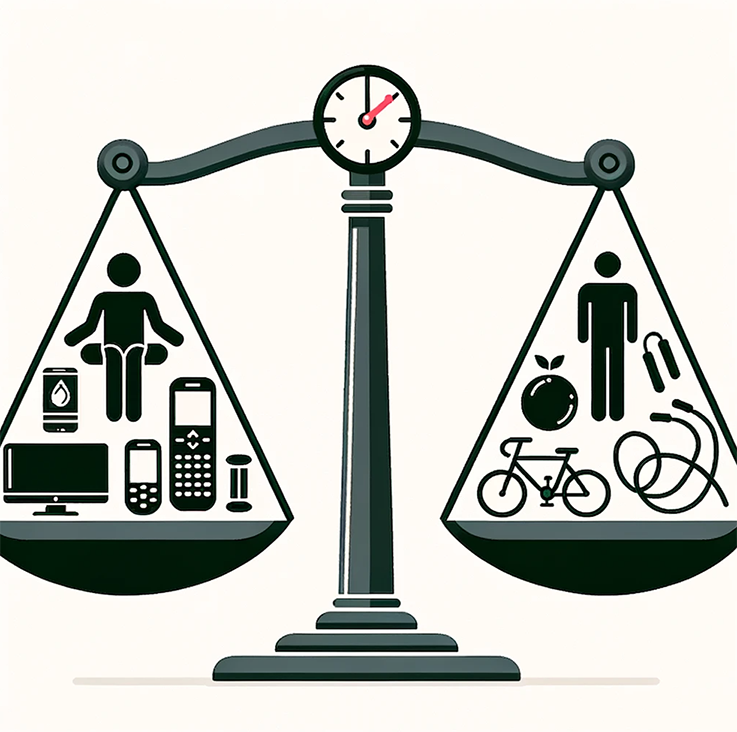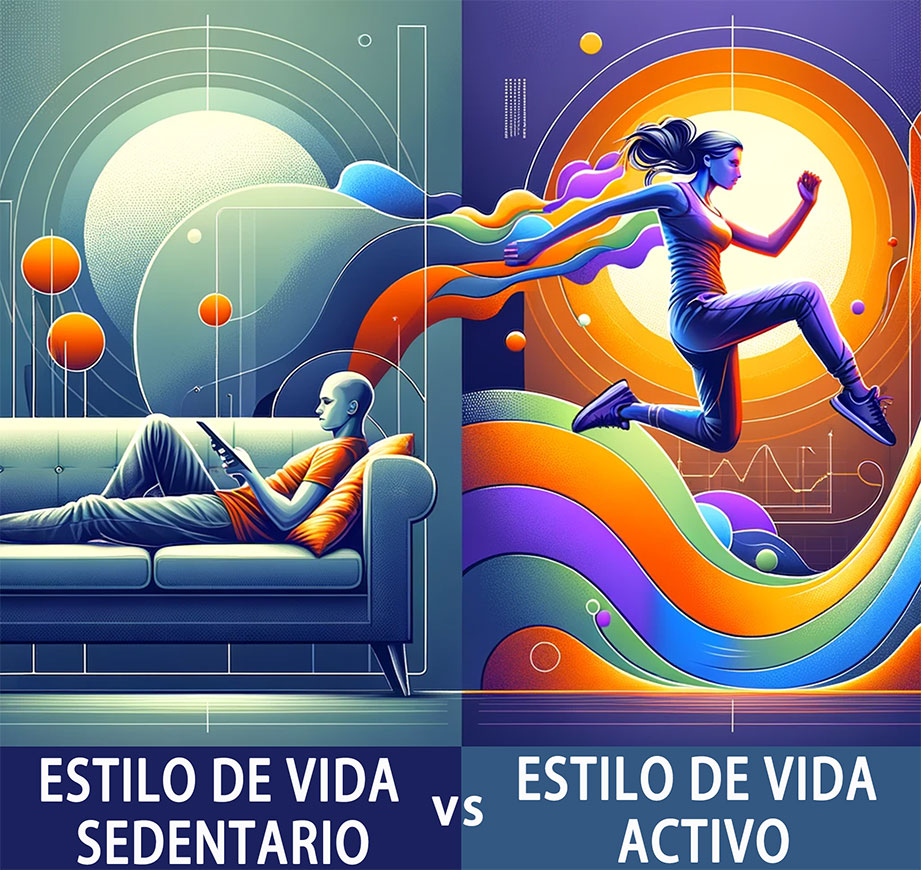Sedentary lifestyle and Its Health Risks
The Silent Peril: Understanding Sedentary lifestyle and Its Health Risks
1. Introduction
In today’s fast-paced world, where convenience is prized and technology reigns supreme, we find ourselves in the grips of a silent peril: a sedentary lifestyle. The irony of our time is that as we advance in technology and convenience, our levels of physical activity drastically decline, leading to a plethora of health risks. Understanding the implications of prolonged sitting and inactivity is more crucial now than ever, as it can profoundly impact our overall health and longevity.
Our lives are now intricately intertwined with screens and devices, creating a culture of continuous sitting and inactivity. This sedentary behavior is not just a trend but a lifestyle shift that has significant implications for our health. The term 'sedentary' comes from the Latin word 'sedere', meaning to sit, and it has never been more relevant than in our current societal context.
2. Sedentary Lifestyle - A Historical Context
Tracing back through the annals of history, our ancestors led active lifestyles out of necessity. Hunting, gathering, and farming were the primary means of subsistence, demanding constant movement and physical exertion. Fast forward to the industrial revolution, and we see the first major shift in activity levels. Machines started to take over manual labor, and for the first time, a significant portion of the population found themselves in sedentary jobs.
However, the most dramatic change came in the latter half of the 20th century with the advent of computers and the internet. The technological revolution has anchored us to our seats, creating an increasingly sedentary society. From the first television sets entering our homes to the smartphones now glued to our hands, each technological milestone has played a part in reducing our daily physical activity.

In this journey from active to inactive, our bodies are paying the price. The shift from a lifestyle filled with movement to one dominated by sitting and inactivity has given rise to numerous health risks, making it a public health concern. Chronic diseases such as cardiovascular disease, type 2 diabetes, and obesity are now prevalent, with sedentary behavior being a significant contributing factor.
The World Health Organization has recognized the perils of a sedentary lifestyle, urging nations to adopt policies and practices that encourage more active living. Yet, despite these efforts, the trend towards an increasingly sedentary lifestyle continues, fueled by advancements in technology that prioritize convenience over activity.
The contrast between our active past and our sedentary present is stark. We have transitioned from a world where physical activity was ingrained in our daily lives to one where it is an afterthought. This evolution, or perhaps more aptly, this devolution, highlights the urgent need for a societal shift back towards a more active lifestyle.
As we delve deeper into the topic, we will explore the various facets of sedentary behavior, the health risks associated with prolonged sitting, and strategies to counteract these negative effects. By understanding the roots of our sedentary behavior and its impact on our health, we can start to pave the way towards a more active and healthier future.
3. Technological Impact on Sedentary Behaviour
In our rapidly evolving digital world, the technological advancements designed to streamline our lives and enhance our connectivity have inadvertently tethered us to a sedentary lifestyle. The paradox of progress is that while we celebrate the conveniences brought forth by technology, we must also grapple with its unintended consequences, primarily the escalation of sedentary behavior.

3.1 The Rise of Screens: A Digital Dilemma
Screens have become ubiquitous, and their omnipresence in our daily lives has fundamentally altered our behavior patterns. The allure of the digital world is undeniable, but it comes at the cost of our physical well-being. Let’s dissect this phenomenon further:
-
Work Environment: The modern workplace is dominated by computers. The shift from manual labor to desk jobs has significantly reduced our daily physical activity levels. Even with the advent of ergonomic furniture and standing desks (which you can read more about here), the majority of the workforce still spends hours on end in front of screens.
-
Entertainment and Leisure: Televisions and computers were once the primary screens in our lives, but smartphones and tablets have since joined the fray. Video streaming services and social media platforms create a vortex that’s hard to escape, often resulting in hours of continuous sitting.
-
Education and Learning: With the rise of online courses and digital resources, students of all ages are spending more time engaged in screen-based learning. The convenience of accessing information from the comfort of one’s home is invaluable, but it also contributes to increased sitting time.
3.2 The Double-Edged Sword of Convenience
Technological advancements have undeniably made life more comfortable, but this comfort has a hidden cost. Let’s explore how convenience has become a catalyst for sedentary behavior:
-
Transportation: The advent of automobiles and public transport has drastically reduced the need to walk or cycle. While this has made commuting faster and more efficient, it has also significantly diminished our daily dose of physical activity.
-
Smart Home Devices: Devices that control lighting, temperature, and even appliances have reduced the need to physically engage with our environment. While these smart devices add a layer of efficiency to our lives, they also contribute to a lifestyle characterized by minimal movement.
-
Food Delivery Services: The convenience of having meals delivered to our doorstep is a luxury of the digital age. However, this service, while convenient, discourages the physical activity associated with cooking or dining out.
In summary, the digital age, while enriching our lives in numerous ways, has also ensnared us in a web of sedentary behavior. Balancing the benefits of technology with the need for physical engagement is crucial as we navigate this increasingly sedentary lifestyle. As we move forward, acknowledging and addressing the health risks associated with prolonged sitting will be paramount in fostering a society that values and prioritizes movement.

4. Defining Sedentary Behavior
To effectively address the issue of sedentary behavior, it is crucial to understand what it entails and how it differs from physical inactivity.
4.1 What Constitutes Sedentary Behavior
Sedentary behavior involves any waking activity characterized by an energy expenditure ≤1.5 METs while in a sitting, reclining, or lying posture. Here’s a breakdown of common sedentary activities:
-
Sitting (while working, commuting, watching TV)
-
Lying down (excluding sleeping)
-
Reclining (while using digital devices)
4.2 Distinction between Physical Inactivity and Being Sedentary
While often used interchangeably, physical inactivity and sedentary behavior are distinct concepts:
-
Physical Inactivity: A lack of sufficient physical activity, not meeting the recommended physical activity guidelines. Adults are advised to engage in at least 150-300 minutes of moderate-intensity, or 75-150 minutes a week of vigorous-intensity aerobic physical activity, or an equivalent combination of moderate- and vigorous-intensity aerobic activity.
-
Sedentary Behavior: Engaging in activities that do not increase energy expenditure substantially while in a seated or lying posture.
It is possible for an individual to be physically active and still lead a sedentary lifestyle. For example, one might exercise regularly but spend the majority of the day sitting at a desk job.
4.3 The Health Impact of Sedentary Behavior
Engaging in prolonged sedentary behavior has been linked to numerous health risks, regardless of one’s level of physical activity. The effects of a sedentary lifestyle can be detrimental, leading to a higher risk of chronic diseases and negative health outcomes.
By understanding the nuances of sedentary behavior and its distinction from physical inactivity, we can better strategize ways to mitigate its effects. Integrating movement into our daily routines, irrespective of our exercise habits, is key to counteracting the health risks associated with a sedentary lifestyle.
In the next sections, we will delve deeper into the specific health risks of prolonged sitting, providing insight into why it is imperative to shift towards a more active and less sedentary lifestyle.
5. Health Risks of a Sedentary Lifestyle - The Dangers of Sitting
Engaging in prolonged periods of sedentary behavior has been systematically linked to a plethora of health risks, affecting individuals across all age groups. Recognizing and understanding these health problems is the first step toward mitigating their impact on our lives.
5.1 Cardiovascular Disease: The Heart’s Silent Struggle
Sitting for extended periods can lead to a cascade of negative effects on cardiovascular health. When we sit, blood flow slows down, and muscles burn less fat, making it easier for fatty acids to clog the heart. Prolonged sitting has been linked to high blood pressure, elevated cholesterol levels, and cardiovascular disease. Engaging in regular physical activity is crucial, as it helps to maintain heart health and prevent the onset of heart disease. Here’s an article that delves deeper into the importance of staying active for cardiovascular health.
5.2 Type 2 Diabetes: The Insidious Rise of Blood Sugar
The relationship between sedentary behavior and type 2 diabetes is well-documented. Sitting for long periods can lead to insulin resistance, where the body’s cells are less responsive to the hormone insulin, resulting in elevated blood sugar levels. Making a conscious effort to break up long periods of sitting can aid in blood sugar regulation and reduce the risk of developing type 2 diabetes.
5.3 Obesity: The Caloric Imbalance
Sedentary behavior contributes to obesity by creating a caloric imbalance. When we sit, our caloric expenditure decreases, but our caloric intake does not necessarily follow suit. This imbalance can lead to weight gain and, eventually, obesity, a significant public health concern. Integrating more physical activity into our daily routines is a vital strategy in combating obesity. Check out this article for tips on increasing daily activity.
5.4 Cancer: Unraveling the Hidden Links
Emerging research suggests a potential link between prolonged sitting and an increased risk of certain types of cancer, including colon and breast cancer. The exact mechanisms are still under investigation, but it highlights the importance of adopting an active lifestyle to mitigate cancer risks.
5.5 Musculoskeletal Disorders: The Posture Problem
Spending hours in a seated position can lead to a range of musculoskeletal issues, particularly in the back and neck. Poor posture while sitting can strain the spine and surrounding muscles, leading to discomfort and long-term disorders. Ergonomic workspaces and regular movement breaks are crucial in preventing these issues.
5.6 Mental Health: The Mind’s Silent Suffering
The impact of sedentary behavior extends beyond physical health, affecting mental well-being as well. There is a growing body of evidence suggesting a link between prolonged sitting and mental health conditions such as depression and anxiety. Incorporating physical activity into one’s routine has been shown to have a positive impact on mental health, providing a compelling reason to reduce sedentary time.
5.7 Other Risks: From Poor Circulation to a Shortened Lifespan
The risks associated with sedentary behavior are vast, impacting various aspects of health. Poor circulation, increased risk of deep vein thrombosis, and even a potential reduction in lifespan are all associated with prolonged sitting. Making conscious efforts to move more and sit less is essential for maintaining overall health and longevity.

In conclusion, the health risks associated with sedentary behavior are multifaceted, impacting physical, mental, and emotional well-being. Understanding these risks is a crucial first step, but it is the actions we take to mitigate these risks that will ultimately determine our health outcomes. Adopting an active lifestyle, incorporating regular movement breaks, and being mindful of our daily sedentary time are key strategies in combatting the silent peril of sedentary behavior.
6. Guidelines to Counter Sedentary Behavior
Adopting a proactive approach towards reducing sedentary behavior can significantly mitigate its associated health risks. Here’s a comprehensive guide to help you navigate this path.
6.1 Breaking the Cycle: The Importance of Intermittent Movement
The human body is designed to move, and breaking the cycle of prolonged sitting is crucial. Intermittent movement throughout the day can enhance circulation, improve metabolism, and reduce the strain on muscles and joints. Simple actions like standing up, stretching, or taking short walks every 30 minutes can make a significant difference. Incorporating physical activities like stair climbing or light stretching can further enhance the benefits.
6.2 The Role of Ergonomics: Setting Up a Healthy Workspace
A well-designed workspace can play a pivotal role in reducing sedentary behavior. Ergonomic chairs and desks that encourage good posture, along with accessories like keyboard trays and monitor stands, can help in maintaining proper body alignment. Standing desks have gained popularity as they allow individuals to alternate between sitting and standing, thus reducing total sitting time. Here's an insightful read on creating a healthy workspace.
6.3 Embracing Movement: Simple Exercises and Habits to Incorporate
Incorporating physical exercises into your daily routine is key to counteracting sedentary behavior. This doesn't necessarily mean engaging in intense workouts; even simple activities like walking, gardening, or playing with pets can contribute to overall physical activity levels. Establishing routines such as taking the stairs instead of the elevator or engaging in active play with children can infuse movement into daily life.
| Habit | Description |
|---|---|
| Walking Meetings | Conduct meetings on the go to incorporate movement into work. |
| Desk Exercises | Perform simple stretches and exercises while at your desk. |
| Active Commuting | Walk or cycle part of the way to work if possible. |
| Household Chores | Engage in activities like cleaning and gardening. |
| Playtime | Dedicate time for playing sports or games that require movement. |

6.4 Technology as an Ally: Using Apps and Reminders
Leverage technology to your advantage by using apps and reminders to encourage movement. Set hourly reminders to stand up or move, and use fitness tracking apps to monitor your daily sedentary time and physical activity.
6.5 Establishing a Support System
Having a network of friends, family, or colleagues who share your commitment to reducing sedentary behavior can provide the necessary motivation and accountability. Engage in group activities, share your goals, and celebrate milestones together.
6.6 Educating Yourself and Others
Knowledge is power, and educating yourself about the health risks associated with sedentary behavior and the benefits of an active lifestyle is crucial. Share this knowledge with others to create a collective awareness and commitment to reducing sedentary time.
6.7 Seeking Professional Advice
If you’re unsure about where to start or if you have existing health conditions that might require special consideration, don’t hesitate to seek advice from a health professional.
In summary, counteracting sedentary behavior requires a multifaceted approach, integrating movement into daily routines, optimizing workspaces, leveraging technology, and fostering a supportive community. It’s about making conscious choices every day to move more and sit less, thus paving the way for improved health and well-being.
7. The Global Perspective: WHO's Stand on the effects of a Sedentary Lifestyle
The World Health Organization (WHO) has been a pivotal force in bringing attention to the global issue of sedentary behavior and its associated health risks. Understanding their standpoint provides a comprehensive view of how sedentary lifestyle affects public health on a global scale.
7.1 Overview of World Health Organization (WHO) Guidelines
The WHO has established clear physical activity guidelines to encourage individuals to engage in more active lifestyles and reduce sedentary time. These guidelines recommend that adults should aim for at least 150 to 300 minutes of moderate-intensity, or 75 to 150 minutes of vigorous-intensity physical activity per week. Additionally, minimizing the amount of time spent being inactive and incorporating a variety of physical activities are emphasized.
7.2 Reducing Sedentary Behavior as a Global Health Goal
The WHO recognizes sedentary behavior as a significant risk factor for various chronic diseases, including cardiovascular disease, type 2 diabetes, obesity, and certain types of cancer. Addressing this issue is considered vital for preventing premature death and improving overall population health.
7.3 The Relationship Between Sedentary Behavior and Health Outcomes
Systematic reviews and research conducted by the WHO and other health organizations have established a strong association between sedentary behavior and negative health outcomes. The evidence suggests that prolonged sitting time and physical inactivity are linked to a higher risk of chronic disease, mortality, and reduced quality of life, particularly among older adults.
7.4 Recommendations for Different Age Groups and Populations
The WHO's physical activity guidelines are tailored for different age groups and populations, recognizing the varying needs and capabilities of individuals. For adults and older adults, engaging in a mix of moderate and vigorous activities, along with muscle-strengthening activities, is advised. Reducing sitting time and incorporating more physical activity into daily routines are emphasized across all age groups.
7.5 The Role of National and Global Initiatives
National health departments and global initiatives play a crucial role in promoting physical activity and reducing sedentary behavior. The WHO encourages countries to implement policies and programs that create supportive environments, enhance community awareness, and provide opportunities for people to lead more active lives.
7.6 The Sedentary Behavior Research Network and Collaborative Efforts
The Sedentary Behaviour Research Network (SBRN) and similar organizations collaborate with the WHO to advance research, share knowledge, and promote policies related to sedentary behavior. These collaborative efforts aim to enhance our understanding of sedentary behavior and its health impact, leading to more effective interventions and strategies.
In summary, the WHO's standpoint on sedentary behavior highlights the urgency of addressing this global health issue. Through comprehensive guidelines, research initiatives, and collaborative efforts, the organization strives to mitigate the health risks associated with sedentary lifestyles and foster a culture of active living for improved public health.

8. Everyday Tips for Getting Enough Physical Activity
Adopting strategies to reduce sedentary behavior is crucial for maintaining good health and preventing associated health risks. Here are some practical tips for incorporating more activity into your daily routine, whether at work, home, or during leisure time.
8.1 Workplace Strategies
-
Standing Desks: Consider using a standing desk or a convertible workstation to alternate between sitting and standing.
-
Walking Meetings: Swap traditional meetings for walking ones, encouraging movement while discussing work matters.
-
Active Commuting: If possible, bike or walk to work. Alternatively, park further away or get off public transport a stop early to increase daily steps.
-
Take Regular Breaks: Set reminders to stand up, stretch, or take a short walk every 30 minutes.
8.2 At-Home Activities
-
DIY Projects: Engage in home improvement tasks that require physical effort.
-
Dance: Put on your favorite music and dance around the house.
-
Gardening: Tend to your garden; activities like digging, planting, and weeding are great for staying active.
-
Play with Pets: If you have pets, spend time playing with them outdoors.
8.3 Mindful Practices
-
Awareness: Be conscious of your sitting time and make a deliberate effort to reduce it.
-
Set Reminders: Use smartphone apps or timers to remind you to stand up and move.
-
Practice Mindful Movement: Incorporate activities like yoga or tai chi to stay both physically and mentally active.
9. Conclusion
In concluding, it is imperative to recognize the gravity of sedentary behavior and its profound impact on our health. The transition from an active past to a predominantly sedentary lifestyle poses significant health risks, including chronic diseases like cardiovascular disease, type 2 diabetes, obesity, and more.

Through this article, we have delved deep into understanding sedentary behavior, its historical context, technological influences, and the plethora of associated health risks. More importantly, we have explored tangible guidelines and everyday strategies to counteract these risks, emphasizing the crucial role of breaking the cycle of inactivity.
As we wrap up, the call to action is clear: it is incumbent upon each of us to take proactive steps in our daily routines to mitigate the perils of a sedentary lifestyle. Whether it’s making small adjustments at work, embracing movement at home, or simply being mindful of our activity levels, every effort counts.
For additional resources and tips on maintaining an active lifestyle, be sure to check out related articles such as Getting Fit: How Much Exercise Is Recommended, and Step Up Your Health.
Let’s not underestimate the power of movement. It’s time to step up, break the chains of a sedentary lifestyle, and pave the way for a healthier, more active future.


 Español
Español Deutsch
Deutsch English GB
English GB




Leave a Reply Cancel Reply